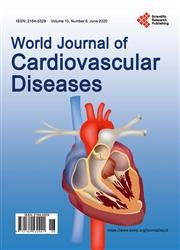Transcatheter Aortic Valve Replacement in High-Risk Surgical Patient with Severe Aortic Insufficiency
引用次数: 0
Abstract
Background: Transcatheter aortic valve replacement (TAVR) is approved by the FDA for severe aortic stenosis (AS) in patients of all surgical risk categories but has yet to be studied for its utility in aortic insufficiency (AI), despite the need for a safe alternative to surgery for prohibitive surgical risk patients. Case Report: We describe a case of a female patient who presented with acute decompensated congestive heart failure (CHF) with New York Heart Association (NYHA) Class IV symptoms. She was found to have severe AI leading to acute decompensation. Two years prior to this, she had aortic valve endocarditis that had potentially resulted in severe AI. Considering her underling comorbidities including diabetes mellitus, hypertension, morbid obesity and multiple myeloma on active chemotherapy at the time of evaluation, the patient was a high-risk surgical candidate for surgical aortic valve repair (SAVR) in view of elevated risk of mortality, infection, and poor wound healing. After critical and comprehensive assessment, transcatheter aortic valve intervention was considered to be an appropriate choice of treatment. TAVR was successfully performed that resulted in immediate improvement of aortic valve func-tion. On subsequent follow-ups, she demonstrated markedly improved symptoms and reduced status to NYHA Class II HF symptoms. Conclusion: TAVR is a potential treatment modality for patients with severe AI who are poor surgical candidates for SAVR. We hope our case contributes to the growing pool of studies investigating the utility of TAVR procedure in patients with severe AI.经导管主动脉瓣置换术治疗严重主动脉不全高危手术患者
背景:经导管主动脉瓣置换术(TAVR)已被FDA批准用于所有手术风险类别的严重主动脉瓣狭窄(AS)患者,但尚未研究其在主动脉功能不全(AI)中的应用,尽管需要一种安全的手术替代方案。病例报告:我们描述了一例女性患者谁提出了急性失代偿性充血性心力衰竭(CHF)与纽约心脏协会(NYHA)四级症状。她被发现患有严重的人工智能,导致急性代偿丧失。在此之前两年,她患有主动脉瓣心内膜炎,可能导致严重的AI。考虑到患者的潜在合并症包括糖尿病、高血压、病态肥胖和多发性骨髓瘤,在评估时正在积极化疗,鉴于患者死亡率、感染风险升高和伤口愈合不良,该患者是手术主动脉瓣修复(SAVR)的高危手术候选者。经过严格和全面的评估,经导管主动脉瓣介入治疗被认为是一种合适的治疗选择。TAVR手术成功,主动脉瓣功能立即得到改善。在随后的随访中,患者表现出明显的症状改善,并降低到NYHA II类HF症状。结论:对于手术条件差的严重AI患者,TAVR是一种潜在的治疗方式。我们希望我们的病例有助于研究TAVR手术在严重AI患者中的应用。
本文章由计算机程序翻译,如有差异,请以英文原文为准。
求助全文
约1分钟内获得全文
求助全文

 求助内容:
求助内容: 应助结果提醒方式:
应助结果提醒方式:


